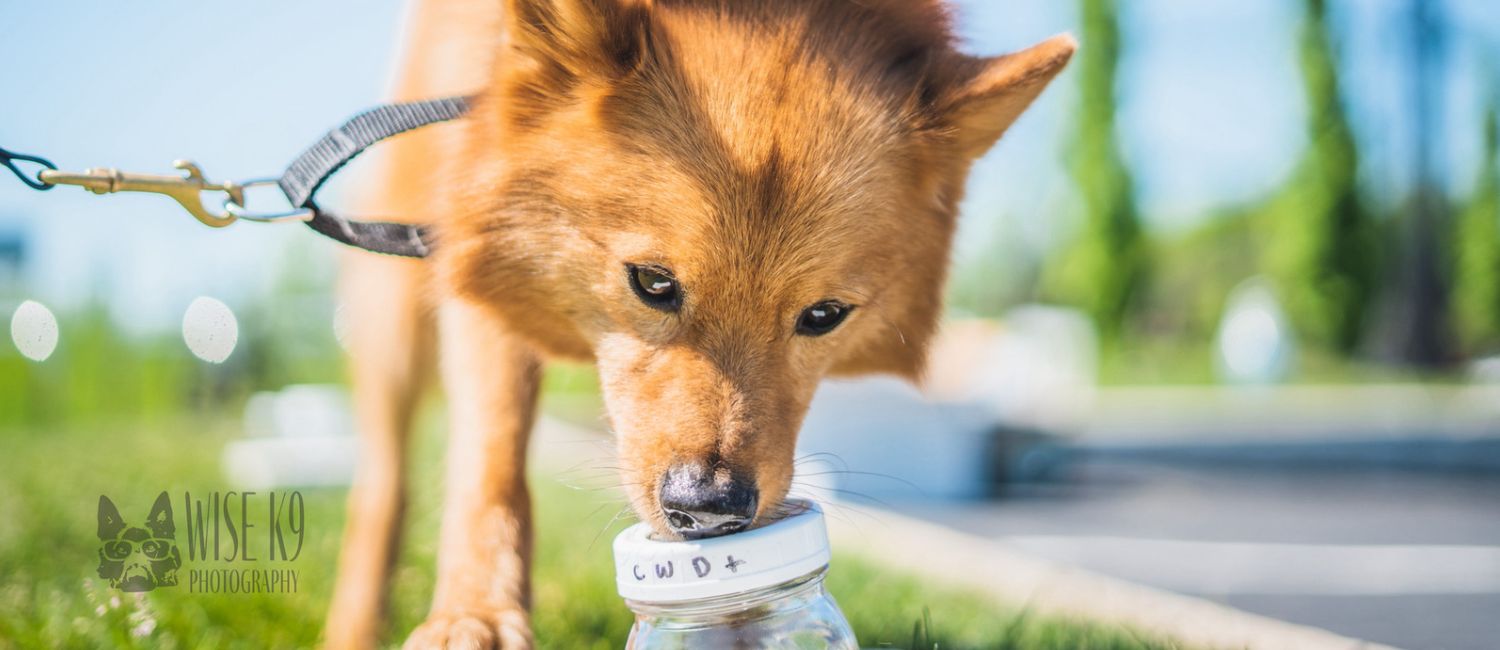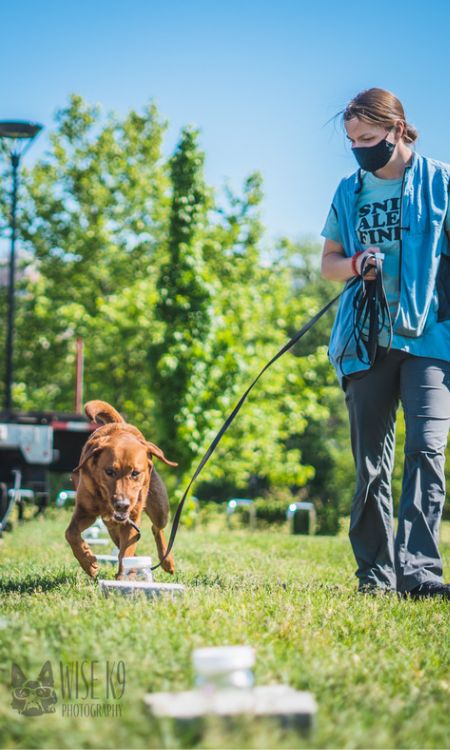 Jari, an 8-year-old Finnish spitz, takes in the odor of a sample taken from a deer with chronic wasting disease. Penn Vet scientists are working to see whether detection dogs trained to discern the disease’s scent could be employed as a tool in helping contain its spread. (Image: Shelby Wise/Wise K9 Photography)
Jari, an 8-year-old Finnish spitz, takes in the odor of a sample taken from a deer with chronic wasting disease. Penn Vet scientists are working to see whether detection dogs trained to discern the disease’s scent could be employed as a tool in helping contain its spread. (Image: Shelby Wise/Wise K9 Photography)
Charlie, Jari, and Kiwi are pet dogs with a superpower: Their sensitive noses can distinguish between a healthy deer and one sick with chronic wasting disease (CWD), all from a whiff of the deer’s poop.
That’s the finding of a study by scientists from Penn’s School of Veterinary Medicine, published in the journal Prion. Using feces samples from CWD-positive deer and deer in which CWD was not detected, the researchers trained the dogs to identify the odor of CWD, alerting their handlers to its presence in the lab and in the field.
“We were already quite certain that the dogs could detect the volatile organic compounds released by chronic wasting disease in feces,” says Amritha Mallikarjun, a postdoctoral researcher in Penn Vet’s Working Dog Center and lead author on the study. “Not only did we show this was possible, but we also answered a second, more interesting question, which is, Can they detect the disease in a simulated field setting, as they would if we were using the dogs to find the disease in the landscape of a forest or on a deer farm?”
The dogs indeed could, with enough accuracy to suggest that detection dogs could be a useful strategy in the fight to manage CWD.
“We learned a lot through the study and are now set up well to continue refining our training,” says Cynthia Otto, the senior author on the study and director of the Working Dog Center.
CWD is a disease that affects a variety of deer species, including white-tailed deer, mule deer, and elk. Always fatal and highly contagious, the disease can hide away in an affected animal for a year or two before symptoms manifest: the deer losing weight—“wasting”—and developing neurological signs, like stumbling and drooling. No cure or treatment exists.
The disease has been in Pennsylvania since 2012, and the state has invested significantly in trying to contain it, with several tools in place for keeping tabs on its spread. One hurdle is figuring out which deer are affected. A healthy-looking but infected animal could shed prions, malformed and infectious proteins, for many months or even years before succumbing to the illness. What’s more, prions are known to bind to soil, potentially contaminating the land on which other animals may roam.
The gold-standard diagnostic test can only be performed after death by assessing an affected animal’s brain. Some alternative tests have been trialed that involve taking a biopsy from a potentially infected animal while it’s still alive, but deer are known to be highly stressed by being captured, and collecting these samples can be physically and logistically difficult for the people involved as well.
 Sarah Kane, a former research assistant at the Penn Vet Working Dog Center, works with Labrador retriever Charlie to assess CWD samples in the field. (Image: Shelby Wise/Wise K9 Photography)
Sarah Kane, a former research assistant at the Penn Vet Working Dog Center, works with Labrador retriever Charlie to assess CWD samples in the field. (Image: Shelby Wise/Wise K9 Photography)
The Working Dog Center, the Pennsylvania Department of Agriculture, and the Wildlife Futures Program, a partnership between Penn Vet and the Pennsylvania Game Commission, were well positioned to try to contribute an additional technique for managing the disease: dogs and their highly sensitive noses. Ideally, dogs trained to discern CWD-positive from CWD-not-detected feces in a forest or deer farm could help state agencies and private landowners understand whether further testing or management would be needed to keep their land and herds free from the disease.
First, scientists had to prove the dogs could make this distinction reliably. The Working Dog Center began by enlisting three dogs from their citizen science program—Labrador retrievers Charlie and Kiwi and Finnish spitz Jari—to train on the Center’s “scent wheel,” a contraption equipped with eight ports, each containing a specific substance or scent.
The dogs proved adept at this task. Once they had been trained, using samples provided by the U.S. Department of Agriculture and processed by the Wildlife Futures Program, the dogs responded with great specificity, passing by the not-detected samples 90-95% of the time. Their sensitivity, however, was not as strong, alerting to just 40% of the positive samples. Overall, the researchers found that the dogs spent more time at the ports containing positive samples than those with not-detected samples, suggesting that they perceived a difference even if they didn’t always produce the trained response, such as a bark or sitting down when they smelled the positive sample.
Moving toward a more naturalistic setting, the researchers then experimented with having the dogs and their handlers try to discern CWD-positive samples placed throughout a large, privately owned field. To avoid contaminating the soil or having the dogs come in contact with the samples, two-gram samples of feces were placed in jars with mesh lids to allow the odor to waft out and then partially buried in the ground in different areas.
The researchers observed that the dogs responded to the positive samples more often than the not-detect samples in the field trial. In total, they detected eight of 11 positive samples in the field, with a false negative rate of 13%. Both handlers and dogs seemed to improve as they went, their accuracy increasing after their first field search.
“Given the amount of time that we trained these dogs and the novel environment, not to mention the fact that these are pet dogs and not trained search dogs, our results are promising,” says Mallikarjun. “As we move forward and work with dogs that are specifically trained to search in a field setting and devote their entire lives to detecting this odor, they are going to do an even better job.”
That’s a step the Wildlife Futures Program is already taking, with canine handlers training “professional” detection dogs how to canvas fields and forests, searching for CWD.
The researchers believe that, while dogs don’t represent a silver bullet in the fight against CWD, they may prove useful as an early warning system, helping fill gaps in knowledge from other monitoring systems and management approaches.
“These dogs could increase the odds of catching an outbreak early,” says Lisa Murphy, a study co-author and co-director of the Wildlife Futures Program.
The Penn Vet team is also collaborating with other groups not only to work with detection dogs but also to identify the odor dogs may be responding to in order to develop other systems for early detection. The lessons learned could be broadly useful.
“If we’re able to tap into what we’ve learned with chronic wasting disease and apply it to other issues in agriculture and conservation, these dogs could be a major asset,” Otto says.
Amritha Mallikarjun is a postdoctoral fellow in the University of Pennsylvania School of Veterinary Medicine.
Lisa Murphy is resident director of PADLS New Bolton Center, a professor of toxicology, associate director of the Institute for Infectious and Zoonotic Diseases, and co-director of the Wildlife Futures Program at Penn’s School of Veterinary Medicine.
Cynthia Otto is a professor of working dog sciences and sports medicine and director of the Working Dog Center in Penn’s School of Veterinary Medicine.
Mallikarjun, Murphy, and Otto’s coauthors were Penn Vet’s Ben Swartz, Sarah A. Kane, Michelle Gibison, Isabella Wilson, Amanda Collins, Madison B. Moore, Ila Charendoff, and Julie Ellis and the U.S. Department of Agriculture’s Tracy Nichols. Mallikarjun is corresponding author on the study.
The work was supported by the Pennsylvania Department of Agriculture and the Wildlife Futures Program at the University of Pennsylvania School of Veterinary Medicine.